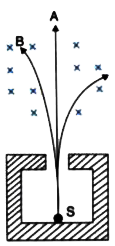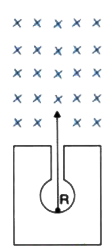Complete Solutions to EXERCISE-12(A) of chapter RADIOACTIVITY of Class 10 book with complete answers and questions
| Class 10 | PHYSICS |
| Chapter | RADIOACTIVITY |
| SELINA PUBLICATION | EXERCISE-12(A) |
| Number Of Questions | 50 |
| Academic Year | 2023-24 |
Name the three constituents of an atom and state mass and charge of each. How are they distributed in an atom ?
02:52View SolutionDefine the following terms :
(a) atomic number, and (b) mass number.03:08View SolutionWhat is nucleus of an atom ? Compare its size with that of the atom. Name its constitutents. How is the number of these constituents determined by the atomic number and mass number of the atom ?
02:10View SolutionState the atomic number and mass number of ` ""_(11)^(23) Na` and draw its atomic model.
04:29View SolutionWhat are isotopes ? Give one example.
02:29View Solution(i) What are isobars?
(ii) Give one example of isobars.02:03View SolutionWhat is the name given to elements with same mass number and different atomic number ?
02:07View SolutionName the atoms of a substance having same atomic number, but different mass numbers. Give one example of such a substance. How do the structures of such atoms differ ?
02:57View SolutionWhat is meant by Radioactivity ?
00:25View SolutionA radioactive substance is oxidised. What changes would you expect to take place in the nature of radioactivity ? Explain your answer.
02:05View SolutionA radioactive source emits three type of radiations.
(a) Name the three radiations.
(b) Name the radiations which are deflected by the electric field.
( c) Name the radiation which is most penetrating.
(d) Name the radiation which travels with the speed of light.
(e) Name the radiation which has the highest ionising power.
(f) Name the radiation consisting of the same kind of particles as the cathode rays.04:04View SolutionAnswer the following questions.
(a) Name the radiation of zero mass.
(b) Name the radiation which has the lowest ionising power.
( c) Name the radiation which has the lowest penetrating power.01:37View SolutionThe diagram in Fig. shows a radioactive source S placed in a thick lead walled container. The radiations given out are allowed to pass through a magnetic field (shown as X) acts perpendicular to the plane of paper inwards. Arrows show the paths of the radiations A, B and C.
(a) Name the radiations labelled A, B and C.
(b) Explain clearly how you used the diagram to arrive at the answer in part (a).
 03:22View Solution
03:22View SolutionFig. 12.8 shows a mixed source R of alpha and beta particles in a thick lead walled container. The particles pass through a magnetic field in a direction perpendicular to the plane of paper inwards as shown by x. (a) Show in the diagram how the particles get affected. (b) Name the law used in part (a).
[Hint : alpha particles will deflect to the left while beta particles to the right]
 03:38View Solution
03:38View SolutionExplain why alpha and beta particles are deflected in an electric or a megnetic field, but gamma rays are not deflected in such a field.
[Hint : alpha and beta particles are changed, but gamma rays are uncharged]02:32View SolutionExplain why alpha and beta particles are deflected in an electric or a megnetic field, but gamma rays are not deflected in such a field.
[Hint : alpha and beta particles are changed, but gamma rays are uncharged]02:32View SolutionState following four properties each of `alpha`, `beta` and `gamma` radiations : (a) nature, (b) charge, ( c) mass, and (d) effect of electric field.
04:01View SolutionCompare the ionising power of `alpha`, `beta` and `gamma` radiations.
01:46View SolutionState the speed of each of `alpha`, `beta` and `gamma` radiations.
02:59View Solution(a) What is the composition of `alpha`, `beta` and `gamma` radiations? (b) Can a hydrogen ` (""_(1)^(1) H)` nucleus emit an alpha particle ? ( c) Which one `alpha`, `beta` or `gamma` radiation has the least penetrating power ?
03:06View SolutionHow are `gamma` radiations produced ? Mention two common properties of the gamma radiations and visible light.
01:32View SolutionAn `alpha`-particle captures (i) one electron, (ii) two electrons. In each case, what does it change to ?
01:42View SolutionRadioactivity is a nuclear phenomenon'. Comment on this statement.
01:13View SolutionWhat kind of change takes place in a nucleus when a `gamma`-particle is emitted ? Express it by an equation. State whether (a) atomic number, and (b) mass number are conserved in a radioactive `gamma`-decay ?
02:09View SolutionA certain radioactive nucleus emits a particle that leaves its mass number unchanged, but increases its atomic number by one. Identify the particle and write its symbol.
03:21View SolutionWhat happens to the (i) atomic number, (ii) mass number of the nucleus of an element when (a) an `alpha`-particle, (b) a `beta`-particle, and ( c) `gamma` radiation, is emitted ?
03:57View SolutionWhat happens to the position of an element in the periodic table when its nucleus emits (a) an `alpha`-particle, (b) a `beta`-particle and (c ) `gamma` radiation ? Give reason for your answer.
01:35View SolutionWhat changes occur in the nucleus of a radioactive element when it emits (a) an alpha particle, (b) a beta particle, ( c) gamma radiation ? Give one example, in each case (a) and (b) in support of your answer.
02:21View SolutionAn atomic nucleus A is composed of 84 protons and 128 neutrons. The nucleus A emits and alpha particle and is transformed into a nucleus B.
(i) What is the composition of B ?
(ii) The nucleus B emits a beta particle and is transformed into a nucleus C. What is the composition of C?
(iii) What is mass number of the nucleus A ?
(iv) Does the composition of C change if it emits gamma radiations ?03:31View SolutionA certain nucleus A ( mass number 238 and atomic number 92 ) is radioactive and becomes a nucleus B (mass number 234 and atomic number 90) by the emission of a particle.
(a) Name the particle emitted.
(b) Explain how you arrived at your answer.
( c) State the change in the form of a reaction.03:30View SolutionState whether the following nuclear disintegrations are allowed or not (star indicates an excited state). Give reason if it not allowed.
(a) `""_(Z)^(A) X _(**) to _(Z)^(A) X + gamma`
(b) `""_(Z)^(A) X to _(Z-2)^(A) X + _(2)^(4) He`02:22View SolutionA nucleus ` ""_(11)^(24) Na` is `beta`-radioactive.
(a) What are the numbers 24 and 11 called ?
(b) Write the equation representing `beta`-decay.
(c ) What general name is given to the product nucleus with respect to ` ""_(11)^(24) Na` ?02:51View SolutionA nucleus of stable phosphorus has 15 protons and 16 neutrons.
(a) What is its atomic number and mass number ?
(b) The nucleus of radio phosphorus has one neutron more than the stable nucleus. What will be its atomic and mass number ?
(c ) What will be the atomic number and mass number of new nucleus formed by the decay of a `beta`-particle by the radio phosporus in part (b) ?02:45View SolutionAn element P disintegrates by `alpha` emission and the new element suffers two further disintegrations, both by `beta` emission, to form an element Q. Explain the fact that P and Q are isotopes.
03:21View SolutionA nucleus ` ""_(Z)^(A) X` emits 2 `alpha` particles and 1 `beta` particle to form a nucleus ` ""_(85)^(222) R`. Find the atomic number and mass number of X.
03:11View SolutionComplete the following sentences :
(a) The mass number and atomic number of an element are not changed when it emits ………………….
(b) The atomic number of a radioactive element is not changed when it emits …………………………… (c ) During the emission of a beta particle, the ................. number remains same.03:56View SolutionComplete the following nuclear changes :
(a) `""_(x)^(a) P to Q +_(-1)^(0) beta`
(b) `""_(92)^(238) U to_(90)^(234) Th +.....+ en ergy`
(c ) `""_(92)^(238) P overset (alpha)(to) Q overset (beta)(to) R overset (beta)(to) S`
(d) `""_(Z)^(A) X overset (alpha)(to) X_1 overset (gamma)(to) X_2 overset (2beta)(to) X_3`
(e) `"" X overset (beta)(to) X_1 overset (alpha)(to) X_2 overset (alpha)(to)_(69)^(172) X_3`04:53View SolutionName one radio isotope and state its use.
00:53View SolutionWhy are the alpha particles not used in radio therapy ?
[Hint : alpha particles cannot penetrate the human skin]01:59View SolutionWhy do we usually use isotopes emitting gamma radiations as radioactive tracers in medical science ?
[Hint : gamma radiations are most penetrating]01:58View SolutionWhen does the nucleus of an atom tend to be radioactive ?
01:03View SolutionWhich of the following is the radio isotope in each pair (a) (b) and (c ) ?
(a) ` ""_(6)^(12) C, _(6)^(14) C` (b) ` ""_(15)^(30) P, _(15)^(32) P` (c ) ` ""_(19)^(39) K, _(19)^(40) K`
Give reason for your answer.02:28View SolutionState the medical use of radioactivity.
03:17View SolutionArrange the `alpha`, `beta` and `gamma` radiation in ascending order of their biological damage. Give reason.
01:34View SolutionName two main sources of nuclear radiations. How are the nuclear radiations harmful ?
02:54View SolutionState two safety measures to be taken while establishing a nuclear power plant.
03:13View SolutionWhat is meant by nuclear waste ? State one way for the safe disposal of nuclear waste.
02:57View SolutionState three safety precautions that you would take while handling the radioactive substances.
01:58View SolutionWhy should a radioactive substance not be touched by hand ?
02:17View SolutionWhat do you mean by background radiations ? Name its two sources. Is it possible for us to keep ourselves away from it ?
04:07View Solution
EXERCISE-12(A) questions and complete solutions for chapter RADIOACTIVITY of SELINA PHYSICS (ENGLISH) of Class 10
